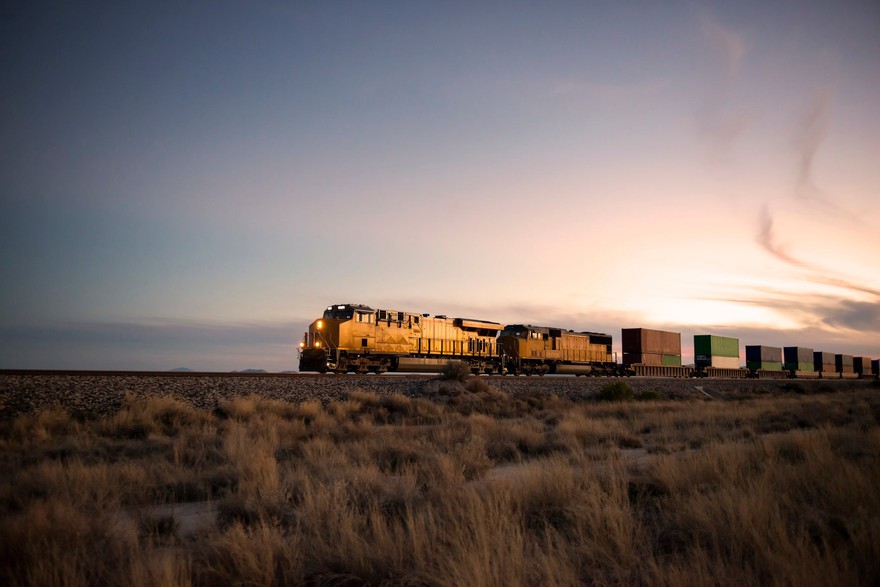Railroad stocks were responsible for one of the first big investment booms in U.S. history. More than a century later, railroads remain a key part of the economy. Railroad stocks offer ownership in the companies that operate in the railway industry. Over the years, the industry has consolidated to a handful of titans responsible for moving most of the goods around the country and to and from ports.

As shippers and truckers faced disruptions during the COVID-19 pandemic, railroads held up better than most because of their unique 24/7 business model and ability to move a lot of cargo with very few people. And in an age where fuel efficiency is increasingly a priority, railroads are only growing in importance as the transportation solution of choice.
Transportation stocks tend to be cyclical, but rail holds up better than most in an economic downturn because rail companies are larger and better capitalized than trucking companies. Despite high oil prices leading to higher fuel bills, railroads also tend to do well when fuel costs spike because trains can transport a lot more cargo than trucks for each gallon of diesel burned.
For much of the 20th century, the railroad industry was plagued by bankruptcies. But today, thanks to years of consolidation and a recent push known as Precision Scheduled Railroading, the remaining companies are able to get more from their assets. The changes have brought down costs throughout the industry and allowed the companies to return more cash to shareholders.
Five railroad stocks to buy right now
| Name and ticker | Market cap | Industry |
|---|---|---|
| Union Pacific (NYSE:UNP) | $138.9 billion | Road and Rail |
| Canadian Pacific Kansas City (NYSE:CP) | $66.8 billion | Road and Rail |
| Canadian National Railway (NYSE:CNI) | $60.4 billion | Road and Rail |
| CSX (NASDAQ:CSX) | $68.0 billion | Road and Rail |
| Norfolk Southern (NYSE:NSC) | $71.3 billion | Road and Rail |
1 - 3

NYSE: UNP
Key Data Points
Union Pacific (UNP -0.08%) is one of two large railroads operating in the western half of the country. Its track connects the ports of Los Angeles and Long Beach with U.S. population centers. Union Pacific has long had a reputation among investors as the best-run U.S. railroad, with vast stretches of track through rural areas and connections to western energy assets.
Like most railroads, Union Pacific pays a dividend, with the stock yielding about 2.1% in late 2025. Over the past five years, the railroad has increased revenue at a compound annual rate of about 2.2%. Union Pacific is also seeking to consolidate the industry, in 2025 announcing plans to combine with Norfolk Southern.
2. Canadian Pacific

NYSE: CP
Key Data Points
Canadian Pacific (CP -0.01%) was historically the smaller of the two major Canadian railroads. That changed with the company's 2023 acquisition of Kansas City Southern. The deal gave Canadian Pacific a vast network down the spine of North America to a deep-water port in Mexico. This network, coupled with its existing east-west track across Canada, allows freight to travel around the continent seamlessly.
Railroad mergers have a long history of getting off track, and investors should tread cautiously during what is likely to be a multiyear integration process. But if all goes according to plan, the new Canadian Pacific-Kansas City Southern combination can be a new North American transportation powerhouse.
3. Canadian National

NYSE: CNI
Key Data Points
Canadian National (CNI -1.33%) has been public only since the mid-1990s, but the government entity-turned-private company provides access to almost every corner of Canada and a shipping link to the Gulf of Mexico. The railroad has more than 20,000 route miles of track and hauls agricultural products, energy, and containers from coast to coast.
Canadian National offers something that its U.S. counterparts can't match: Access to both the Atlantic and Pacific oceans, as well as all geography in between. The company is well-positioned to benefit from strong demand for Canadian energy assets and the impact of companies bringing their supply chains to North America.

4. CSX

NASDAQ: CSX
Key Data Points
CSX (CSX -0.30%) is primarily focused east of the Mississippi River, with more than 20,000 miles of track and access to 70 ports. Due to the more congested landscape, East Coast railroads have historically been less efficient than their Canadian and Western counterparts.
Still, CSX has made great strides in recent years in improving its operations. CSX has delivered compound annual growth of more than 9% over the past five years.
CSX has officially existed only since 1980, but it is a combination of a number of railroads that have been around since the dawn of the U.S. rail age, including the Baltimore & Ohio, the oldest in the nation. The company faces the challenge of maintaining and modernizing many century-old assets along the rails, but it has still generated reliable profits.
5. Norfolk Southern

NYSE: NSC
Key Data Points
Norfolk Southern (NSC -0.14%) is the other Eastern-focused railroad, operating more than 19,000 track miles across 22 states and the District of Columbia. The company is a major transporter of industrial, agricultural, and consumer products and is a primary source of transportation for coal and auto parts. Norfolk Southern also has an extensive intermodal network in the East that carries containers from ship hulls to truck flatbeds.
It remains to be seen how long Norfolk Southern will be an independent company. The railroad has agreed to a merger with Union Pacific -- although the deal is subject to regulatory review and could take years to close.
How to invest in railroad stocks
- Open your brokerage app: Log in to your brokerage account where you handle your investments.
- Search for the stock: Enter the ticker or company name into the search bar to bring up the stock's trading page.
- Decide how many shares to buy: Consider your investment goals and how much of your portfolio you want to allocate to this stock.
- Select order type: Choose between a market order to buy at the current price or a limit order to specify the maximum price you're willing to pay.
- Submit your order: Confirm the details and submit your buy order.
- Review your purchase: Check your portfolio to ensure your order was filled as expected and adjust your investment strategy accordingly.






